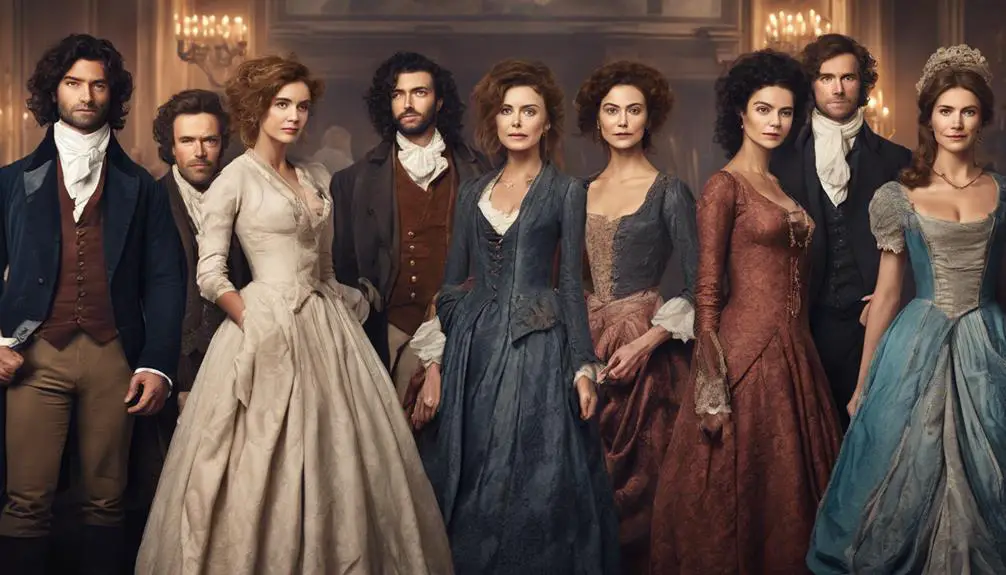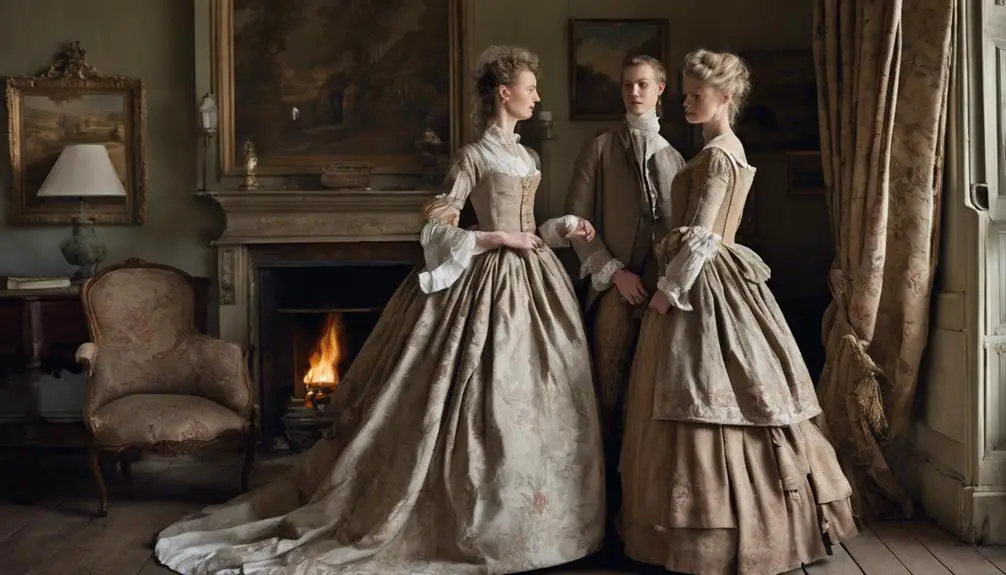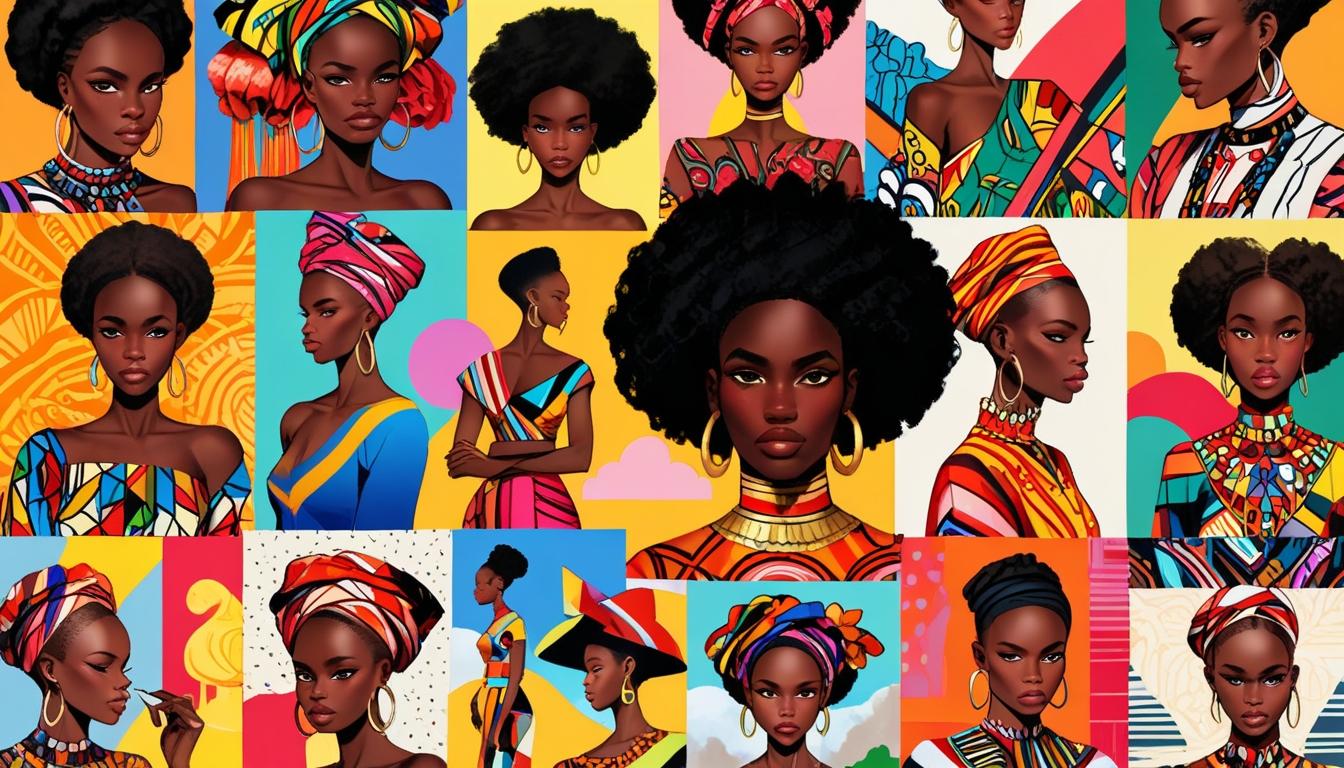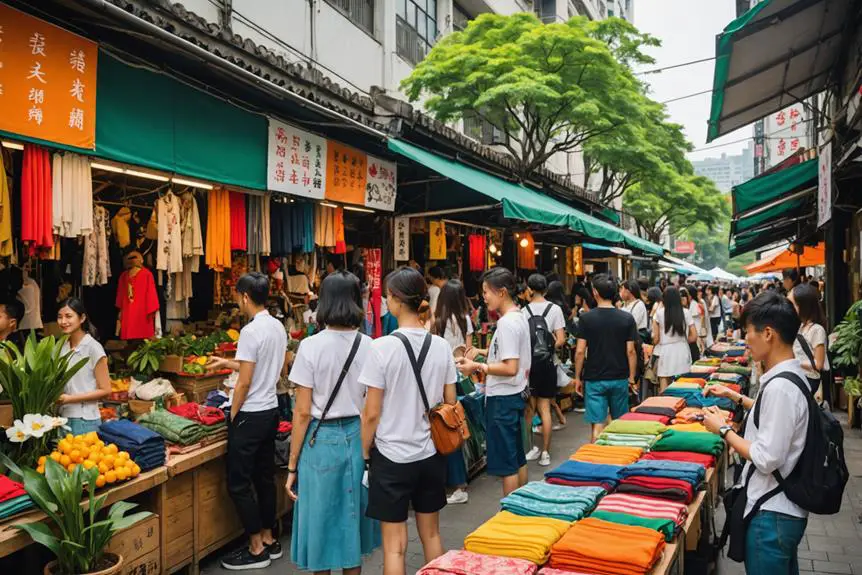When you watch "Poldark," it's hard not to notice how each outfit plays an essential role in illustrating the characters' development and social dynamics. You might find yourself pondering how Demelza's vibrant gowns contrast with Elizabeth's subdued elegance, reflecting their differing journeys. The meticulous period details not only enhance the storytelling but also invite analysis of the fashion trends of the 1780s. However, have you considered how these choices impact audience perceptions of class and identity? There's much more to explore in the intricate world of "Poldark" costumes.
The Role of Costume Design

Costume design's impact on "Poldark" can't be overstated. When you explore the world of this show, you instantly notice how the costumes bring the 1780s Cornwall setting to life. Marianne Agertoft, the mastermind behind the costumes, really nails it. She doesn't just throw on some old clothes; she carefully picks fabrics and styles that reflect the characters' social standings and personal journeys.
Take Demelza, for example. You see her transformation through her wardrobe, moving from boyish outfits to elegant dresses. Isn't it fascinating how a simple change in clothing can symbolize such growth? The upper-class characters flaunt high waistlines and luxurious silks, while the provincial folk keep it more modest. It's like a visual story that helps you understand who these people are without them saying a word.
Even though some folks grumble about historical inaccuracies—especially with the male costumes—you can't help but appreciate the emotional pull these outfits have. They spark curiosity and discussions, showcasing how powerful costume design can be. Plus, the process is super collaborative, constantly adjusting to fit the characters' personalities and storylines.
Character Evolution Through Fashion
When you watch "Poldark," it's hard not to notice how fashion tells the story. Just think about how Demelza's outfits change from tomboyish to elegant, showing her growth and new social status. And let's not forget Ross's rugged look—doesn't it just scream rebellious antihero?
Costume Symbolism and Growth
How do characters in Poldark use fashion to reflect their journeys? In this costume drama, Demelza's costume journey is a standout. She starts off in boyish attire, which shows her humble beginnings, but as she grows and finds her place in the Poldark family and society, her wardrobe transforms into elegant, feminine dresses. This change isn't just about looking pretty; it symbolizes her personal growth.
Take, for example, the stunning turquoise blue gown she wears during key moments with Ross. The color captures the emotional weight of their relationship, adding depth to their interactions. You can really feel her character's evolution through these choices.
And let's not forget Elizabeth! Her cotton prints and nightgowns scream upper-class status, showing us her traits and position. The Warleggans flaunt their fashion, while the more restrained styles of provincial Cornwall highlight class distinctions.
Fashion as Character Reflection
Fashion in "Poldark" serves as a powerful lens through which you can witness character evolution. Just think about Demelza! She starts off in boyish attire that shows her humble beginnings and practical nature. But as the series moves on, her style transforms into more feminine designs, mirroring her growth and social ascent. That stunning turquoise blue gown she wears during pivotal moments? It's not just pretty; it signifies her emotional journey and relationships.
Now, take a look at Elizabeth. Her wardrobe of cotton prints and elegant nightgowns screams upper-class expectations, contrasting sharply with Demelza's evolving style. And what about Captain Ross Poldark? His military uniform—though not perfectly accurate—captures his rebellious spirit and antihero vibe perfectly.
The costume designers really nailed it, connecting the mens and womens clothes to each character's arc. They even made practical adjustments on set to guarantee that each Poldark costume aligns with the narrative. So, next time you watch, pay close attention! You might just see how these outfits reflect the characters' stories and personalities. Pretty cool, right?
1780s Fashion Trends

Alright, let's talk about the fashion trends of the 1780s in "Poldark"! You'll notice how the outfits really reflect social class, with those high waistlines and tailored coats showing off status. Doesn't it make you wonder how much clothes can say about a person?
Key Fashion Elements
The 1780s brought distinct fashion elements that shaped the characters in "Poldark." High waistlines and low necklines defined women's dresses, often crafted from sheer white cotton for both practicality and beauty. Doesn't that sound stylish? These dresses seem to float effortlessly, making the women look graceful and elegant.
On the other hand, men sported slim frock coats and fitted pantaloons, showcasing their social status through tailored silhouettes and luxurious fabrics. You can imagine how dapper they looked! The upper classes really embraced this style, with nightgowns featuring fitted bodices and pleated skirts becoming popular among characters like Elizabeth and Verity.
The shift from Rococo frilliness to more tailored styles made an impact on the costume design. It aimed for historical accuracy, but also represented the characters' personalities. Accessories were kept minimal, focusing on the main garments and silhouettes. This restrained style reflects the vibe of provincial Cornwall, which is a nice contrast to the extravagance of Georgian London.
Social Class Representation
Costume design in "Poldark" vividly illustrates the social class distinctions of the 1780s through its fashion choices. You can really see how upper-class folks, like Elizabeth, strut around in luxurious nightgowns made of silk taffeta, while the lower-class characters stick to simpler, more practical outfits. It's like a visual lesson in who's who!
Women's fashion back then featured high waistlines and low necklines, showing off their status. The Warleggans, for instance, flaunt the latest trends, while the provincial styles of Cornwall are much more restrained. And let's not forget the regional differences—Truro's fashion isn't nearly as extravagant as what you'd find in Georgian London.
You'll notice key character transformations, too. Take Demelza, who evolves from wearing boyish attire to donning beautiful gowns, symbolizing her rise in social status. It's pretty inspiring! Plus, the show nails the historical accuracy of mourning attire. Characters wear black garments, sticking to those 18th-century customs. So, whether it's a robe à la or a simple gown, "Poldark" does a fantastic job showcasing the rich tapestry of social class through fashion!
Key Outfits in Poldark
In Poldark, key outfits not only define characters but also reflect their emotional journeys and societal roles. Take Demelza's stunning turquoise blue taffeta gown, for example. It's more than just a pretty dress; it symbolizes her pivotal moments in relationships. Inspired by actual 1780s dresses, it showcases the emotional depth of her character. You can really feel her growth through that gown!
Then there's Caroline's 2×06 Power Suit. Made from aubergine ribbed wool and featuring a high stiffened collar, it reflects the stylish influences of the 1760s and 1770s. This outfit isn't just chic; it highlights her status and determination, making her stand out in any scene.
Let's not forget the 2×10 Plymouth Ensemble, a high-waisted dress in heavy dark green wool. This piece incorporates Regency design elements, showing how women's fashion evolved during this period. It's fascinating how the designers drew inspiration from artists like Thomas Gainsborough, who captured the essence of the era in his paintings.
Formal events often see upper-class characters like Elizabeth and Verity donning elegant nightgowns, sticking to the fashion of the time. And George? His modern hairstyle and clothing choices scream wealth, contrasting sharply with other characters.
These outfits in Poldark aren't just wardrobe choices; they're visual storytelling tools that bring the world of the show to life. Don't you just love how costumes can say so much?
Audience Reactions to Costumes

Viewers are captivated by the costumes in "Poldark," drawn in by the intricate designs and rich historical references that bring the characters to life. You can't help but admire the authenticity and detail in the wardrobe choices. It's like stepping into another time! Many fans have gushed over Demelza's transformative gowns, pointing out how they mirror her character development throughout the series. Isn't it fascinating how outfits can tell a story of their own?
The emotional impact of key dress designs really stands out, too. Take Elizabeth's stunning turquoise blue taffeta gown, for instance. That dress doesn't just look good; it symbolizes pivotal moments in character relationships that resonate with audiences. You might even feel a little tug at your heartstrings when she wears it!
While the visual storytelling shines through, some viewers have voiced their critiques about certain male character outfits, pointing out historical inaccuracies. It sparks lively discussions about authenticity in period dramas. Who knew costumes could stir up such passionate debates?
Historical Accuracy Challenges
"Poldark's" costume designers faced a delicate balancing act, working to achieve historical accuracy while ensuring the outfits remained visually appealing and true to the characters' personalities. It's no easy feat! For instance, take Ruth Teague's laced-front dress. It might look great on screen, but it wasn't quite right for the 1780s, where dresses were typically fastened at the center front.
Then there's the issue of the women's skirts. You may have noticed they seemed less voluminous than what you'd expect from that time. In reality, ladies rocked bum pads and multiple petticoats to create a fuller silhouette. So, while the skirts in the TV series looked stylish, they didn't quite scream "historical accuracy."
Budget constraints also played a big role in the costume choices. Sometimes, the designers had to recycle garments and skip on decorative elements like ribbons and feathers. It's like trying to create a gourmet meal with a fast-food budget!
And let's not forget about the male characters. Some critiques pointed out their costumes didn't always hit the mark either. Balancing creative expression with what viewers know about history is tough. How can you please everyone?
In the end, "Poldark" embodies the challenge many period dramas face: making history look good while staying true to it. So, next time you watch, remember the hard work behind those beautiful outfits!
Legacy of Costume Design

Costume design in "Poldark" has left a lasting mark on both the genre and modern fashion. You might not realize it, but the way the costumes blend historical accuracy with creative flair really sets the show apart. The designers tackled the challenge of capturing the 1780s while keeping the outfits functional for the actors. So, those stunning dresses and tailored coats aren't just pretty—they're practical too!
Have you ever noticed how some outfits seem to tell a story all on their own? That's the magic of "Poldark." Each costume helps you connect with the characters, making their emotions and struggles feel real. Fans often celebrate the attention to detail that brings these outfits to life, making them more than just clothes. They become part of the storytelling, much like a Joshua Reynolds painting that captures a moment in time.
And let's talk about trends! The show has influenced modern fashion by bringing back classic silhouettes and intricate details, which resonate with today's audiences. It's like a refreshing change in the style world, showing that history can inspire contemporary looks. As you watch, you might find yourself wondering what the future holds for period dramas. Given the excitement "Poldark" generated, it's clear that its legacy will inspire new designers to explore historical aesthetics. So, next time you see a beautiful costume, remember, it's not just clothing—it's a piece of history!
Frequently Asked Questions
Whose Dress Was Demelza Wearing?
You might notice Demelza's fashion reflects historical accuracy, showcasing her character's evolution. Each dress she wears symbolizes significant moments, blending period-appropriate designs with emotional depth, enhancing your understanding of her journey and relationships.
How Old Is Demelza in Poldark Season 1?
Demelza's age in Season 1 is around 18, showcasing her character development as she grows from a naive girl into a strong, independent woman. Her youth influences her relationships and experiences throughout the series.
Who Did the Blue Dress Belong to in Poldark?
While many gowns fade into obscurity, the blue dress symbolizes Demelza's character fashion evolution. It's hers, representing her journey and growth, contrasting with the constraints of her past, enchanting viewers and enriching the narrative.
Who Made the Costumes for Poldark?
You'll find that the costumes for Poldark were crafted by Marianne Agertoft, focusing on costume design and historical accuracy. Her dedication guaranteed each garment authentically reflected the characters and their journeys throughout the series.



